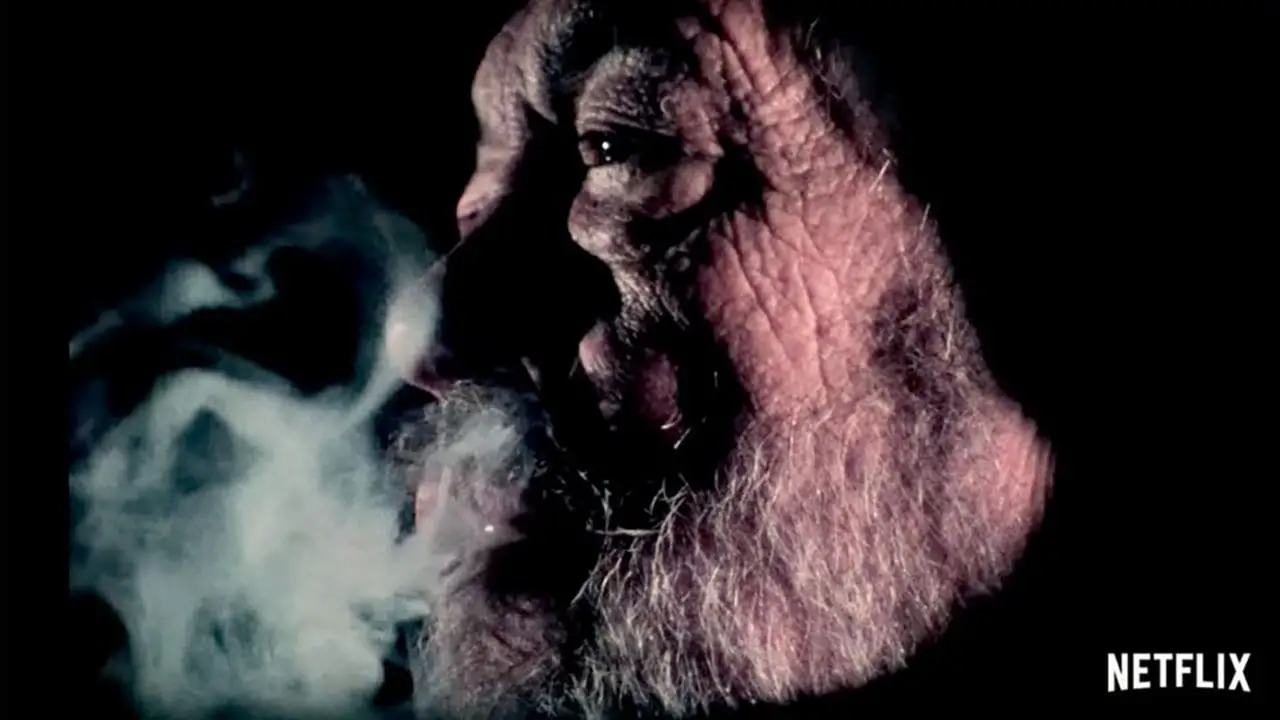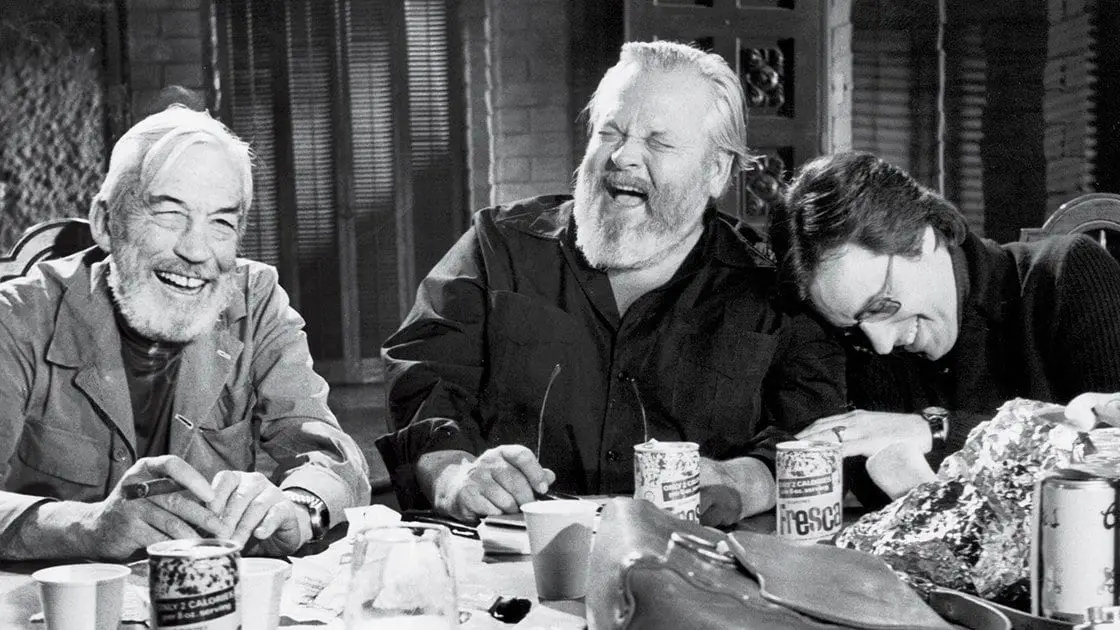The Other Side of the Wind, a film that took nearly 50 years to piece together, is currently streaming on Netflix. That sentence alone would be enough to make the man that made the film look at you cross-eyed, and unless you’re previously acquainted with Orson Welles’ work, life, and turbulent relationship with Hollywood, hearing that there is a new Orson Welles movie on Netflix would give you as much pause. This thought lends to the fact that Welles was usually impressively and depressingly ahead of his time. This film, unlike Welles’ more well-known titles, is made as a satire that follows (and I mean literally follows countless handheld cameras on foot, in cars, through power outages and changes in venue) the story of the laughably macho Jake Hannaford (John Huston) and his entourage, as they try to procure funding to finish the film-within-a-film, which is of course titled The Other Side of the Wind.
The film within the actual film is shot without dialogue and revolves around two main characters: The Actress (played by Oja Kodar), who also helped direct the actual film; and her male counterpart John Dale (played by Bob Random). The film is supposed to be an experimental European-style arthouse film, involving gratuitous sex scenes to make up for the lack of a plot. Hannaford’s film is the equivalent of watching an old dog learn quantum physics, and when his leading man walks off the set in the middle of filming, it becomes clear that the film is never going to receive funding—especially since the answer to losing his leading man was to replace him with numerous mannequin dummies, which honestly could have worked given the style the movie was supposed to have, but it looks far too unintentional to be pulled off. As Welles’ film is seen as deeply autobiographical outside of Hannaford’s film—which Welles has said is something he would clearly never make in real life—the story in the film about Hannaford trying to get the film made seems very true to Welles’ life. Hannaford is trying to finish what he sees as his magnum opus, but his style and personality are too well-known by old Hollywood producers. Also, the new pack of Hollywood wolves aren’t well-funded enough to give him the monetary access he needs, and while the young crew love the thought of financially backing him, it seems like a terrible idea.

While Welles was noted as saying that this film isn’t autobiographical and it needs to stand alone as a film, you’ll be hard-pressed to find anyone that agrees with the statement. The similarities between Welles’ real timeline and Hannaford’s fictional timeline coincide far too closely for most to say one doesn’t have to do with the other. After having been fired from directing Touch of Evil (1958), a film most of us now wouldn’t understand at all the controversy it stirred up in Hollywood when it was made, Welles had recently returned to the United States after a 20-year hiatus in Europe. Hannaford in The Other Side of the Wind is also returning from a long stay in Europe, only to come back with a movie he sees as groundbreaking, which will bring something new to the old Hollywood table and revive his career. Welles’ film deals in how movies are made and how inevitable betrayal is in the movie industry. There are many sources available that can detail Welles’ life and the many betrayals he personally faced—the easiest to access right now being They’ll Love Me When I’m Dead, the documentary of how The Other Side of the Wind was made (also currently streaming on Netflix). If you’re not too familiar with Welles’ work, I’d give the documentary a watch as well, as it makes The Other Side of the Wind a bit easier to follow and pick apart.
The Other Side of the Wind is not going to be the easiest sell for your friends that aren’t already movie buffs or possibly Welles fans in general. I say that with no malicious intent, though. The film just isn’t family-friendly or even user-friendly, as it is just as bizarre in some scenes as it is dazzling. You may even have to put your phone down through the entire film *gasp* to make sure you don’t miss one of the 10 or more cameos, including Dennis Hopper, and if he and Orson Welles can’t collectively get you to unglue from your cellphone then I honestly don’t know what can. There are a number of reasons why the film isn’t the easiest pill to pop, including constant camera changes from black and white to color, language and phrases that will make some do a double take, and rapid-fire character introductions. A lot of the actors in the film aren’t in movies anymore and haven’t been for decades, so it’s not as easy as recognizing your current favorite blockbuster heartthrobs. On top of all of that, the film deals with something most people actively fear (or just have lurking in the back of their minds), waiting to jump out at them as they fall asleep.

What if we grow up, dedicate our lives to something and try with all our heart, but still, no-one remembers us? Worse yet, what if we spend all that time trying, and still somehow don’t make a difference? What if we’re just as insignificant as we fear we are? Even if you’re a movie star or a big shot director, you’re still fleeting, and if we survive the next couple of hundred years, do you really think your name will make it through the ages? While that question alone isn’t new to being put on the big screen, I’ve seen few films pull it off with quite the style that this one did. The film doesn’t make you want to curl up and assume the position—it makes you feel like you should really get up and do something while you have a moment.
At the end of the day, all of those things that make this movie hard to watch for some is also what makes it strikingly mesmerizing. Orson Welles made a movie that he loved and wanted others to see and enjoy or learn from (at least he tried his very best to). The film took six years to shoot originally, then funding ran out and politics came into play (because why shouldn’t politics get in the way of art?) Then Welles died in 1985, leaving behind more than just this film unfinished. People that had worked alongside Welles knew how important the film was to him though, so various people made waves trying to get the film finished every few years. It took the film almost 50 years, some legal battles, and outlasting a mournful amount of its crew to finally be made. Some say the film should never have been finished at all since Welles wasn’t around to make it exactly what he wanted. I have to think, given the nature of the film itself, Welles would have been pleased to see people still running around trying to help complete his projects because they love and respect him and his art, decades even, after he finally yelled cut.

